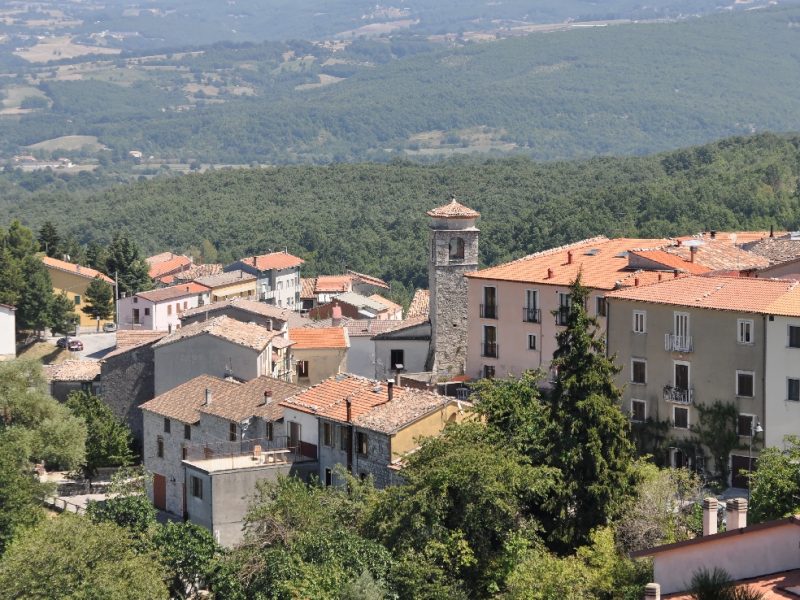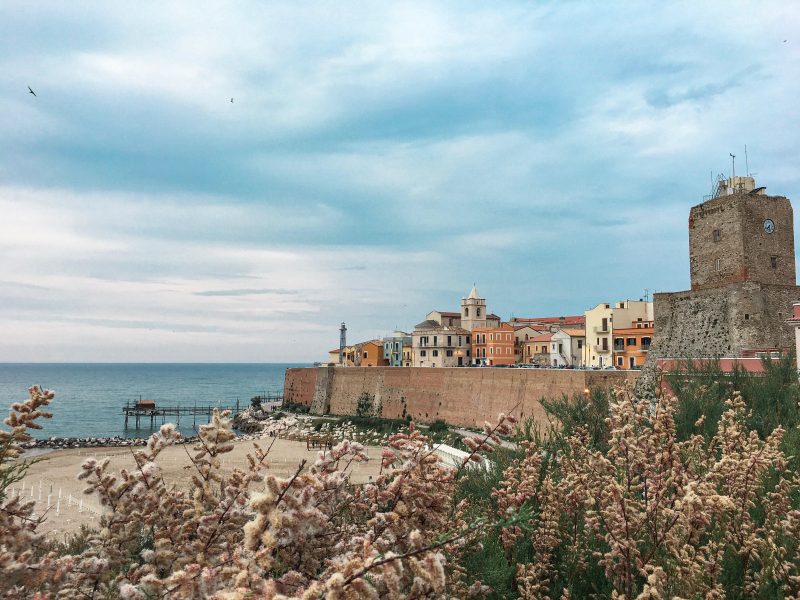The Borgo of Bojano
The origins of Bojano can be found on the battlefields of ancient legends. The lanes of this borgo whisper ancient stories of a powerful city, a city that challenged Rome itself, and almost won.
Bojano is nestled at the foot of the Massiccio del Matese mountain range, surrounded by beech and chestnut woods and the enveloping silence of the slow pace of nature, with streams bubbling up from the natural springs and the calls of animals running through the green shadows of the trees.
Bojano has the all charm of a river city, as mutable as the currents along its shores, modeled by destiny and always ready to be reborn, without interrupting the impetuous course of history.
The best place to admire the ancient borgo is from the ‘Belvedere della Cività’, which in the past was one of the fortified citadels that dominated and protected Bojano.
At dusk, the bustling daily life of the borgo slowly calms, and the streetlights sparkle to life, illuminating the ancient stone lanes as a fresh breeze of magic floats over the town.
History
Bojano was built from the bricks of a past made from battles and men of honor, cemented together with legends and myths. The events of this borgo’s history seem to come straight from the epic imaginations of Virgil or Homer, but there is nothing fictional about them.
The Massiccio del Matese, where Bojano stands, is historically one of the first areas in Europe to be inhabited by homo sapiens. In this territory, the earliest forms of human settlements date back to the Paleolithic era, the echo of this distant past reaching us through the prehistoric findings discovered in the area of Isernia.
Bojano’s origins are intertwined with the ancient Italic populations, but we need to travel back on the timeline to understand the dynamics that led to the foundation of this borgo in Molise. The tribes of the Umbri and the Sabini had been at war for decades, and when the Sabini won a decisive battle, they established a Ver sacrum (sacred ritual): in Spring, they offered fruit and animals to the god Mamert, and sent the young men of the village on a quest to colonize new lands. The expedition was led by a sacred ox, the animal dearest to the God of War. After a long journey, the ox decided to stop and rest at Mount Sannio, where the travelers set up their first encampment. Later, the Samnites would take their name from this mountain. The ox wanted to continue its journey however, and the hopeful colonists followed, until they arrived at the Biferno river, where the ox stopped to slake its thirst. Here, they founded Bovajanum, which later would be called Bojano. Around this new city and its land, the tribe of the ‘Pentri’ was born. Over the centuries, this population grew so much that in the fourth century BC, it was the head of the five tribes in the area of Sannio.
With the passing of time, the Samnite League, as they came to be called, acquired a prominent role on the Italian peninsula, with a vast and ever growing area of influence, spread further by its widely used language, ‘Oscan’ which prevailed over the all the other languages in the territory. The power and success of the Samnite League inevitably began to threaten the interests of the nascent Roman Empire and its fervent desire for expansion. Rome, in fact, was fixated on acquiring the Samnite land beyond the river Liri, and it was around this crucial node that the three Samnite wars broke out. The Samnites proved to be capable warriors and astute strategists, and were able to gain the upper hand, leaving Rome destined to certain defeat. But the final battle changed everything, the fate of the Samnites and entire Italian peninsula. The epilogue of the Samnite wars is known today as ‘The Battle of Nations’, and is remembered as the most violent and bloody military conflict in ancient Italy, ending with victory for the Romans and the fall of Bojano in 293 BC.
The historian Tito Livio tells us that in the period before the wars, Bojano had maintained a position of supremacy over the other towns in the area. It was a large city, securely protected by three fortified citadels and a well-organized army, but even this was not enough to save it.
In 290 BC a peace treaty with Rome had assigned the Samnites the status of socii, meaning that they had no right to citizenship, but were afforded a fictitious autonomy that forced them to submit to duties imposed by the Romans without receiving any benefits in return.
This disadvantageous state of affairs led the Italic populations to instigate new uprisings against the supremacy of Rome: the Civil Wars. During a key battle, just as Rome was about to surrender and leave them in relative peace, the League was betrayed by some of its own tribes, who were seeking to curry favor with Rome in order to obtain full citizenship in the Empire. They obtained it, and not only the traitors were rewarded: Roman citizenship was granted across all the territories, with one exception: the lands governed by the Pentri tribes, who were made to take full and sole responsibility for the battles against Rome. With unflinching military precision, the Romans destroyed their cities and massacred the population, down to the last newborn, and with this final act of genocide, the history of the Samnite people was definitively closed. After five centuries, the Oscan language was forgotten and replaced by Latin, which brought new customs, traditions and religions to the territory.
With great satisfaction, the Roman Empire constructed new colonies in the rebel cities it had razed to the ground. In the area of Bojano, first Bovianum Vetus was constructed, and subsequently, Bovianum Undecimanurum.
For a city, entering the Latin world meant following the fortune and misfortunes of the Empire, reaping both the laurels of victory and the bitter fruits of defeat. For this reason, when Italy was besieged by the wars between the Goths and the Byzantines in the fifth and sixth centuries, Bojano was also dragged into the dark tunnel of war, from which it managed to emerge only in the seventh century, when its lands were entrusted to the Hungarians. In this period the borgo began to flourish, obtaining a role of supremacy over the neighboring cities. This turn of fortune was short lived however: new tribulations awaited the city, with continual invasions from the ruthless Saracens/Ottoman Turks, and two violent earthquakes which devastated the city.
The arrival of the Normans opened a bright new chapter in the history of Bojano, a chapter of fundamental importance. In this period, the fief was entrusted to Rodolfo de Molisio, whose dynasty succeeded in creating the largest county on the peninsula, and it is from his surname that the name of the Molise region is derived.
When Queen Constance of Altavilla passed her Italian territories into the hands of her son Federico II of Swabia, the role of feudal lords lost importance, and Bojano, like the rest of Southern Italy, passed the Middle Ages being governed by a succession of various sovereigns until the advent of the Unification of Italy.
In the post-unification period, Bojano and the rest of Southern Italy were characterized by the mass migration of their populations, as the poorest social classes, unable to feed their families, sought better chances of finding employment by emigrating to the Americas or northern Europe.
During those years, earthquakes and the bombardments of 1943 seriously damaged Bojano and inevitably sealed the fate of the city, which had been set to become the regional capital of Molise, but in its wounded state lost the honor to Campobasso.
Today, the vast expanses of virgin wilderness and the rich historical and cultural heritage of the borgo are its priceless inheritance, a treasure chest that draws thousands of visitors every year to discover this ancient borgo in Molise.
The Cathedral of San Bartolomeo
The Cathedral of Bojana has embraced almost two thousand years of history and strife.
The church is located on the site of a pre-existing place of worship, and was rebuilt by the Molis family, who commissioned the restoration in around 1080. The official date is still debatable, but construction probably began in 1073, as attested by the first document citing the Cathedral. An apse that was unburied during restoration work in 1996 also dates back to that year.
The Cathedral of San Bartolomeo was destroyed by earthquakes several times, and it was rebuilt and restored for just as many. In the bombardments during the Second World War, the only thing left standing was the bell tower and the presbytery, and yet again, the church was rebuilt and opened for worship in 1948.
Today, only a few traces remain of the ancient, original construction: the Gothic style portal and the central rose window, crafted in concentric circles. However, the church still recounts its long journey over the ages through the small details hidden within its walls. The bell tower has conserved the massive boulders of its original construction, which probably date back to the Samnite period, and there also Roman epigraphs and a capital from the Lombard period, as well as thirteen ‘tommoli’ from the Middle Ages.
The interior is divided into three naves and two series of pointed arches, with an entirely barrel-vaulted ceiling. Along the walls various niches hold the statues of saints, among them, a carved wooden statue of San Bartolomeo from the Neapolitan school, dating back to the year 1700.
Three apses in raised positions also correspond to the three naves, and over the central apse you can still admire two paintings that were saved from the 1943 bombings.
On one side of the presbytery, there is a staircase composed of seven steps, symbolizing the seven capital sins, and descending, you reach the crypt, which is also visible from the presbytery through glass panels positioned in the floor.
The Cathedral of San Bartolomeo is probably one of the most ancient churches in the Christian world, and is surely unique in its kind: during one of its many restorations, an apse was found under the main alter, with a natural spring flowing from it.
Civita Superiore
The ancient borgo of Civita Superiore overlooks the town of Bojano from high on its hill. It was one of the fortified citadels that protected the urban center during the Samnite era. Today, it has retained all its fascination, with poetic angles and charming lanes, even though the borgo has deteriorated with the passing of time.
In the past, the borgo of Civita could be accessed by three city gates: Porta San Giovanni on the south wall, Porta da Basso on the east, and La Portella on the north side, a characteristic making the citadel unique in the region.
The belvedere overlooks the new city of Bojano, and from the same point you can admire the Pandone Castle, one of the most ancient in the region.
The castle was constructed for defensive purposes, to protect the ruling lord and the population during attacks from neighboring populations and the invasions of the Saracen Turks.
Between 1400 and 1500 the castle became the summer residence of the Bishop Pandone, and a little borgo developed around it.
The Hermitage of di Sant’Egidio
The Hermitage of Sant’Egido can be reached by a country road immersed in groves of beech and chestnut trees, and is a very special to the inhabitants of Bojano.
The hermitage rests at the foot of the Massiccio Matese, and its origins go back to the ninth century, probably constructed by Cistercian monks or the Knights of Templar. During the Middle Ages, this small shelter offered rest to travelers going from one side of the mountain to the other.
According to local tradition, this hermitage was inhabited for some time by Sant’Egido, who chose this isolated place to immerse himself in prayer. It is said that he was fed by the milk of a deer.
Over the centuries, many hermits chose to live in this small shelter with its little church nearby. Today, the tradition continues: since April 5, 2017, it has been inhabited by Sister Margherita, a nun, who after returning from a mission in Africa, decided to renounce the frenetic life of the modern world and pass the rest of her existence immersed in the silence of prayer.
Ver Sacrum
The Ver Sacrum, the sacred Spring, is an ancient religious rite that led to the birth of the Samnite people and the foundation of the city of Bovajanum.
For centuries, Bojano played a central role among the populations of the Massiccio del Matese, and every year, to honor this glorious past, the ancient rite of Ver Sacrum is re-invoked.
Usually, this re-enactment is held one evening in August, with the hypnotic rhythm of drums and “tamburelli” flooding the streets full of thousands of people in period costumes. The procession begins with a re-enactment of the rite of migration, when the young people left their village on the quest for new lands. Over the course of the evening, various scenes depicting other important historical moments for the Samnite people are presented: religious sacrifices, marriages, the council of elders and the founding of Bojano itself. The organization of the Ver Sacrum involves the entire community of Bojano, which for the occasion, is flanked by a group of noteworthy historians.
Simone and Flavio Sala.
Simone and Flavio Sala are two brothers who share an unbreakable bond: their passion for music.
The oldest of the two, Simon Sala was born in 1982 and is a pianist. At the age of nine he began to study piano, and then entered the “Lorenzo Perosi” conservatory, where he graduated with honors.
During his career he has won several national and international awards and has performed on stages throughout Italy.
In 2008 he founded the “World Music Project”, a touring music festival featuring the collaboration of some of the greatest national and international musicians, such as Vinicio Capossela, Silvia Mezzanotte, Tullio de Piscopo, Billy Cobham and many others.
Since 2015 he has been the artistic director of the jazz festival “Jazz in Campo”.
His passion and his brilliant career have brought him great honor: he has been awarded the ‘Medal of Honor of the Presidency of the Italian Republic’ and the ‘Medal of Honor of the Molise Region’.
His brother Flavio is one year younger, and shares his tenacity and extraordinary musical talent.
Flavio Sala studied at the local conservatory, and then the“Accademia Musicale di Firenze” in Florence and the “Accademia Musicale Chigiana di Pisa”. At eighteen he made his debut by winning the prestigious “ XXVI Concorso Internazionale di Interpretazione Chitarristica di Gargnano” near Brescia, the first in a long line of awards and victories obtained from national and international juries.
His talent is best expressed in concerts and master classes: in the last few years he has performed on the most important stages in Europe and also in Russia, the United States, South America and Cuba.
He is a classical guitarist, but is open to other musical genres, which has allowed him to collaborate with musicians of national and international fame across the globe.
He has lived in the United States and Venezuela and currently resides in Italy.
______________________________________
Do you known of any famous people related to this borgo? Contact us!
The Mozzarella di Bojano
The knife sinks into the firm, velvet-smooth texture of the glistening white cheese, so tender, so fresh, that pearls of moisture form on every mouthwatering slice: the mozzarella of Bojano. This mozzarella has made Bojano famous throughout Italy, and the perfection of this cheese can only be created here, where the hills of the Appennino and the Biferno river have created the ideal ecosystem for its production.
Bojano’s exclusive production process has been handed down from generation to generation and requires rigorous attention: the main ingredient, milk, is procured from cows grazing free on the nutrient-rich grasses of the surrounding pastures, to which is added the incredibly pure water of the Bojano aqueduct. After this, the mozzarella undergoes a salting process by being immersed in water and sea salt, which guarantees conservation.
This culinary marvel is traditionally served fresh, perhaps enhanced by a drizzle of extra-virgin olive oil, as an appetizer or as a main course. Rest assured, however you choose to enjoy the mozzarella of Bojano, it is a slice of heaven!
La tradizione consiglia di gustare questa mozzarella al naturale oppure accompagnata da un filo di olio extravergine locale, come antipasto ma anche come secondo. A noi non resta che fidarci e soprattutto assaggiare!
_________________________________
Do you known other typical recipes related to this borgo? Contact us!

 Italiano
Italiano
 Deutsch
Deutsch






